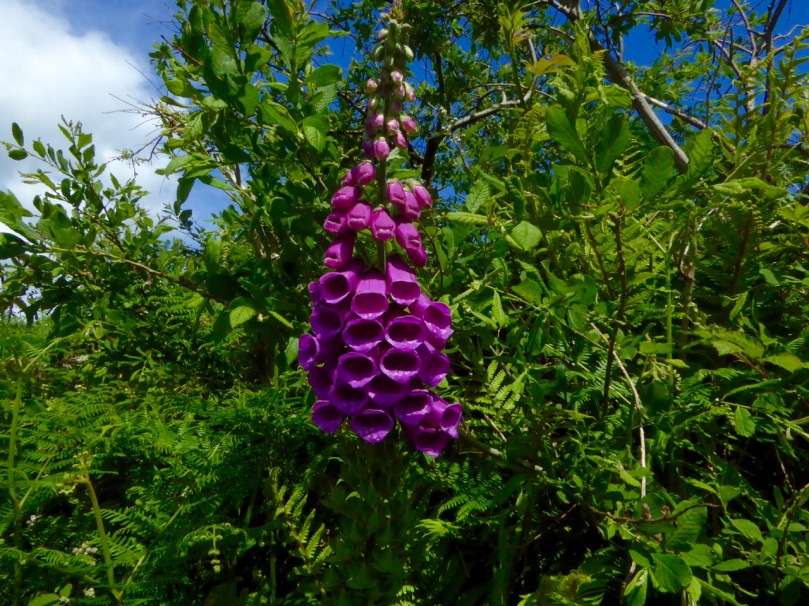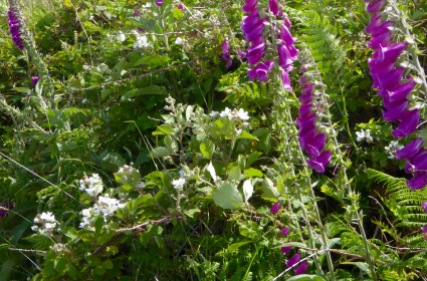Nobody can remember a year like this one for the foxgloves. In fact, all wildflowers seem to be crowding out the boreens and invading the fields everywhere you look, including our own little patch of paradise, above.
Ragged Robin, Oxeye Daisies, Buttercups and Thistles
Along the back road to Schull from Ballydehob
Last year I wrote a post, Close Reading, about the June wildflowers. The theme of the piece was that to really see what was in the hedgerows you should slow down, stop and seek.
Not this year! This year we cycle or walk along fragrant, colourful paths that threaten to overwhelm the senses. The bounty is simply laid out before us.
Foxgloves can have as many as 75 blooms on one stem. This one’s half way there
Foxgloves, tall and straight, are everywhere, singly or in masses. Nobody knows why it’s called foxglove, beyond the obvious explanation which doesn’t seem to quite fit the size of the flower in relation to a fox’s paw. But we do know its latin name, digitalis, was based on the idea of the flower easily slipping over a finger. It’s an important medicinal plant used in heart treatments but highly toxic if ingested raw or improperly, earning it the nicknames dead men’s bells or witches gloves.
They are a native to Ireland, quickly colonising waste ground and common near moorland. Sometimes called fairy thimbles or fairy bells here, they were associated with the little people and it was considered unlucky to have them in the house. That’s good, as they are an important source of nectar for bees and other insects.
This patch was cleared last year and looked barren. Here’s what’s happening now!
The other ubiquitous flowers of June in West Cork are the Oxeye Daisy and the Buttercup, often growing together in a riot of white and yellow. Both are native plants and, like the foxglove happily and quickly colonise any ground that’s been recently cleared. We grew up calling them dog daisies and bringing them home in great bunches for our mother, who would quietly dispose of them once we’d gone to bed – their perfume didn’t match their good looks.
And Buttercups – is there another such yellow? We held them under each other’s chins to see the yellow reflection. If it was there, it meant you liked butter. It never occurred to us to question the validity of the predictive method.
Ragged Robin – such an apt name for this native! A tiny haggard near us is full of them, much visited by butterflies. This lovely flower used to be more common, but the draining of wetlands and boggy areas has left less of their preferred habitat for them.
Scabious is everywhere and its brilliant periwinkle blue plays off beautifully against the yellow of the humble dandelion. The bane of gardeners everywhere, the dandelion was used in Ireland to make a tea that was supposed to be a great tonic for one of ‘consumptive habits.’ As kids, we delighted in blowing the seed heads to see what o’clock it was, and rubbing the milk on our warts as a cure. On a less charming note, we called them piss-a-beds and teased each other that touching them would result in wetting the bed.
 The honeysuckle and the fuchsia are just starting to make their presence felt now. The bramble flowers and the wild roses are punctuating the hedges and the bird’s foot trefoil has taken over part of our lawn. My father waged war on anything but grass on his lawn, especially the little lawn daisies. He didn’t mind us pulling those up to make daisy chains, or to play he loves me, he loves me not.
The honeysuckle and the fuchsia are just starting to make their presence felt now. The bramble flowers and the wild roses are punctuating the hedges and the bird’s foot trefoil has taken over part of our lawn. My father waged war on anything but grass on his lawn, especially the little lawn daisies. He didn’t mind us pulling those up to make daisy chains, or to play he loves me, he loves me not.
Clockwise from top left: Birdsfoot trefoil, Wild Rose, Lawn Daisies, Campion, Foxglove and bramble flower
Of course, there is still a bit of seeking and peering involved for the tiny flowers in the hedges or fields. Speedwell, Herb Robert and Campion (below) reward the slow down and look closely approach.
Flaming June, some people call it (although the original Flaming June is actually a painting), and perhaps this year it’s a better description than ever.





















It would be interesting to see how many children could name three flowers. They are all very common. People are documenting the decline in the number and diversity of words that describe nature in our languages: are the names of these forgotten?
LikeLike
Sounds like a great thesis for someone!
LikeLike
I am always amazed by the profusion of wild flowers growing in our hedgerows and on roadsides. Passing by in the car, you just can’t see them. Take a walk and it’s a miniature jungle out there! I’ve noticed that flowers seem to come in cycles, sometimes they might be profuse for a couple of years, then there’s not so many but some other plant takes its place and is rampant for a while. I love the foxglove. It really is splendiferous! 😁
LikeLike
Like you, we marvelled at the Burren ones lately too!
LikeLiked by 1 person
What an amazing beautiful place we live in! We are so lucky! 😊💕
LikeLike
I recently downloaded a plant app called pl@ntnet and we went for a walk North of Schull Saturday and I was busy using it and learning all the beautiful wildflowers
LikeLike
I looked it up and it looks excellent, although developed for France. Thanks for the tip!
LikeLike
I thought the furse bushes in May were magnificent. So yellow against the lush green.
LikeLiked by 1 person
Just heavenly, aren’t we lucky!
LikeLiked by 1 person
Absolutely adore your photos of this beauty, indeed I have the pleasure of witnessing it around here, what a blessing.
LikeLike
Thank you – and hasn’t this year been particularly wonderful!
LikeLiked by 1 person
Absolutely Finola!
LikeLike
Yes it is unbelievable, along the roads it is so beautiful! The ox-eyed daisies also are plentiful this summer along the roads, hope they won’t be cut.
Love your photo!
LikeLiked by 1 person
Reblogged this on West Cork History.
LikeLike
What an uplifting joy!
LikeLiked by 1 person
Just too lovely for words! I remember doing all those things growing up – I wonder do children still put buttercups under their chins and flow the dandelions to see the time?
LikeLike
Yes, I wonder if they do.
LikeLike